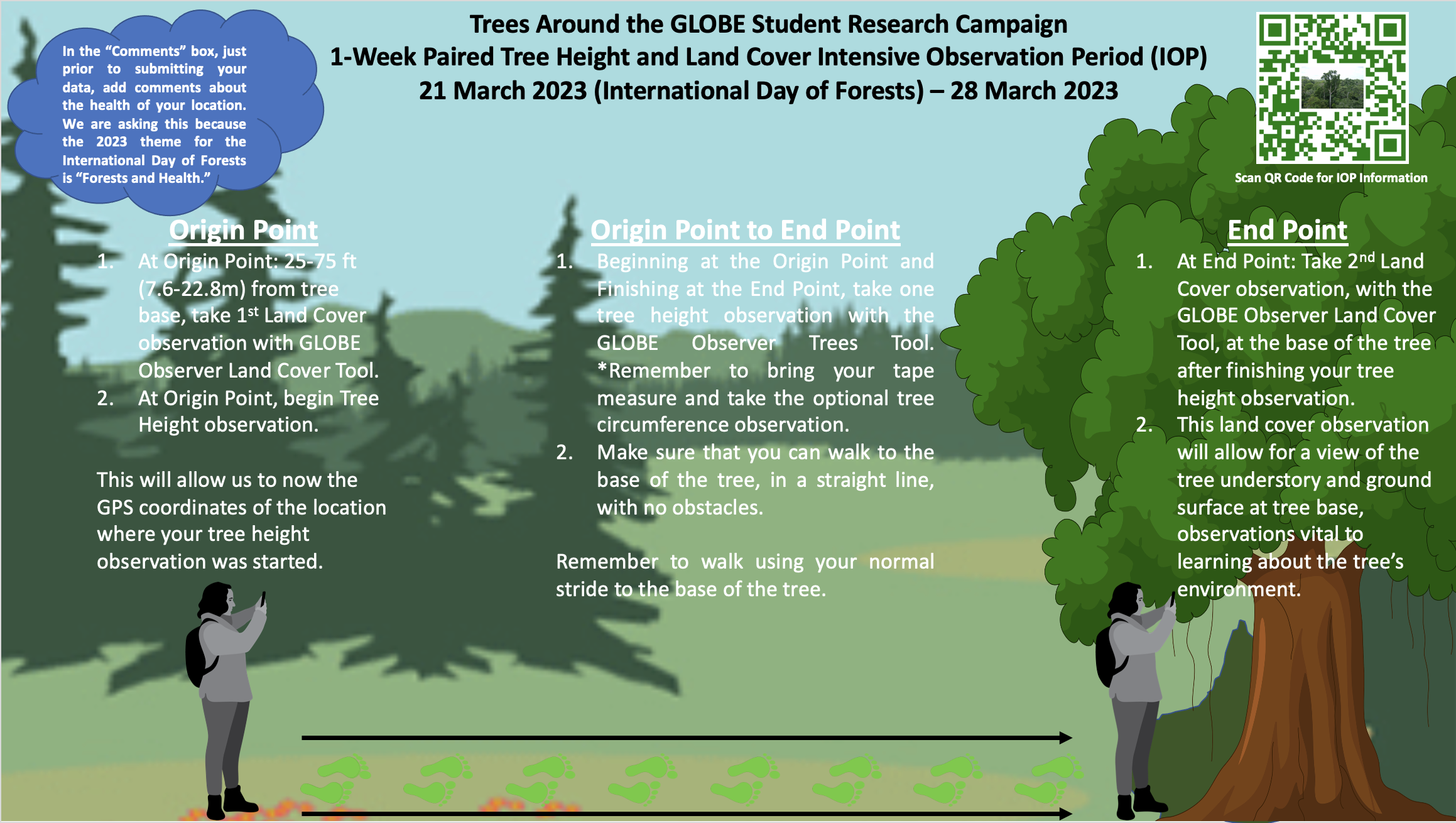1-Week Paired Tree Height and Land Cover Intensive Observation Period (IOP) 2023 - Trees around the GLOBE
Intensive Observation Periods (IOPs)
Intensive Observation Periods (IOPs) are focused periods of time where participants are encouraged to collect large amounts of data and enter it in the GLOBE database. Data that is collected during an IOP will provide other GLOBE students, scientists, researchers, and educators large amounts of concentrated data over a short period of time. This can also be referred to as "Data Density." Ground-based data density can serve as way to help validate data coming from satellites and airborne instruments.
For instance, if GLOBE students take multiple measurements of tree height and land cover over a short amount of time and build up a strong database, scientists working with the ICESat-2 satellite tree height data can use the IOP student data and compare it to the ICESat-2 tree height measurements. Scientists working with land cover data from the Landsat satellite can do the same for land cover.
__________
Stay tuned for upcoming IOPs!
__________
Recent IOPs
The Trees Around the GLOBE Student Research Campaign will be having a 1-Week Tree Height and Land Cover Intensive Observation Period (IOP) from 21 March - 28 March, 2023. This IOP will focus on taking land cover observations at the origin point of a tree height observation and at the base of the tree. We are striving for participants to take 2 land cover observations and 1 tree height observation at the same location. Please see the shareable below for the step-by-step instructions.

The Steps:
Origin Point
- At Origin Point: 25-75 ft (7.6-22.8m) from tree base, take 1st Land Cover observation with GLOBE Observer Land Cover Tool.
- At Origin Point, begin Tree Height observation. This will allow us to now the GPS coordinates of the location where your tree height observation was started.
Origin Point to End Point
- Beginning at the Origin Point and Finishing at the End Point, take one tree height observation with the GLOBE Observer Trees Tool. Remember to bring your tape measure and take the optional tree circumference observation.
- Make sure that you can walk to the base of the tree, in a straight line, with no obstacles. Remember to walk using your normal stride* to the base of the tree.
End Point
- At End Point: Take 2nd Land Cover observation, with the GLOBE Observer Land Cover Tool, at the base of the tree after finishing your tree height observation.
- This land cover observation will allow for a view of the tree understory and ground surface at tree base, observations vital to learning about the tree’s environment.
Additional Information: In the “Comments” box, just prior to submitting your land cover and/or tree height data, add comments about the health of your location. We are asking this because the 2023 theme for the International Day of Forests is “Forests and Health.”
Protocols to use for the IOP
The GLOBE Program's app, GLOBE Observer
*If you are unsatisfied with the stride length the GLOBE Observer automatically calculates for you, based on your height, you can use the "GLOBE Find Your Pace Activity Guide." Also, please note that you can add your manual stride length in the app, just prior to submitting your GLOBE Observer tree height observation.
__________
Land Cover January 2020 Intensive Observation Period
400 Land Cover measurements came in from 229 locations in 10 countries around the world.
The Trees Around the GLOBE Student Research Campaign Team would like to announce the champion for the January 2020 Land Cover Intensive Observation Period:
O. Gupta from GLOBE United States with 101 submitted measurements!
The map below represents the campaign member countries that participated in the 2020 Land Cover IOP.

__________
Tree Height January, April July and October 2019 Intensive Observation Periods

IOP Information:
During each IOP, GLOBE students will:
- Take measurements of tree height or land cover and one additional protocol, from the suite of campaign protocols found at https://www.globe.gov/web/trees-around-the-globe/overview/start-taking-measurements,
- take measurements at least three times per week for one month at
the same study site for both protocols.
- The tree height measurements should be of the same trees each time for each site.
- You can have multiple sites for trees and land cover, thus increasing the number of trees and land covers measured.
Each participant will receive a Virtual Tree Height or Land Cover IOP Badge
The GLOBE school with the most collected tree height data or land cover data and additional protocol data will receive:
· A Virtual one-on-one Q and A session with a NASA scientist, researcher, or engineer.
· Virtual Tree Height or Land Cover IOP Winner Badge
The major goal here is to have students compare their measurements seasonally and with other GLOBE school measurements from around the world.





